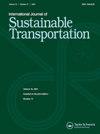驱动未来:价值保持率如何影响电动汽车的采用
IF 3.1
3区 工程技术
Q2 ENVIRONMENTAL STUDIES
International Journal of Sustainable Transportation
Pub Date : 2024-09-01
DOI:10.1080/15568318.2024.2402754
引用次数: 0
摘要
近几十年来,政府一直在推动电动汽车(EV)的采用。然而,在鼓励广泛使用电动汽车方面仍然存在挑战,这可能会影响潜在买家。除了众所周知的购买障碍外,电动汽车的保值率也会影响消费者的决策。本文提出了一个基于线索利用理论的模型,以了解消费者在考虑购买电动汽车时如何对保值率做出反应。该模型还研究了感知质量和两个内在线索--品牌声誉和新产品发布频率--如何影响这种反应。研究结果表明,保值率会影响消费者的评估和购买决策,尤其是在内在线索缺失或不足的情况下。这些研究结果对政府政策、电动车制造商的促销策略和运营管理都有借鉴意义。本文章由计算机程序翻译,如有差异,请以英文原文为准。
Driving the future: How value retention rate shapes electric vehicle adoption
The government has been promoting the adoption of electric vehicles (EVs) in recent decades. However, challenges still exist in encouraging widespread use of EVs, which may impact potential buyers. Aside from the well-known barriers related to purchasing, the rate at which the value of EVs is retained over time may also influence consumers’ decisions. This article presents a model based on cue utilization theory to understand how consumers respond to the value retention rate when considering purchasing an EV. The model also examines how perceived quality and two intrinsic cues - brand reputation and the frequency of new product releases - influence this response. The findings indicate that the value retention rate influences consumers’ assessments and purchase decisions, particularly when the intrinsic cues are absent or insufficient. These findings have implications for government policies, EV manufacturers’ promotion strategies, and operational management.
求助全文
通过发布文献求助,成功后即可免费获取论文全文。
去求助
来源期刊
CiteScore
8.90
自引率
2.60%
发文量
56
期刊介绍:
The International Journal of Sustainable Transportation provides a discussion forum for the exchange of new and innovative ideas on sustainable transportation research in the context of environmental, economical, social, and engineering aspects, as well as current and future interactions of transportation systems and other urban subsystems. The scope includes the examination of overall sustainability of any transportation system, including its infrastructure, vehicle, operation, and maintenance; the integration of social science disciplines, engineering, and information technology with transportation; the understanding of the comparative aspects of different transportation systems from a global perspective; qualitative and quantitative transportation studies; and case studies, surveys, and expository papers in an international or local context. Equal emphasis is placed on the problems of sustainable transportation that are associated with passenger and freight transportation modes in both industrialized and non-industrialized areas. All submitted manuscripts are subject to initial evaluation by the Editors and, if found suitable for further consideration, to peer review by independent, anonymous expert reviewers. All peer review is single-blind. Submissions are made online via ScholarOne Manuscripts.

 求助内容:
求助内容: 应助结果提醒方式:
应助结果提醒方式:


